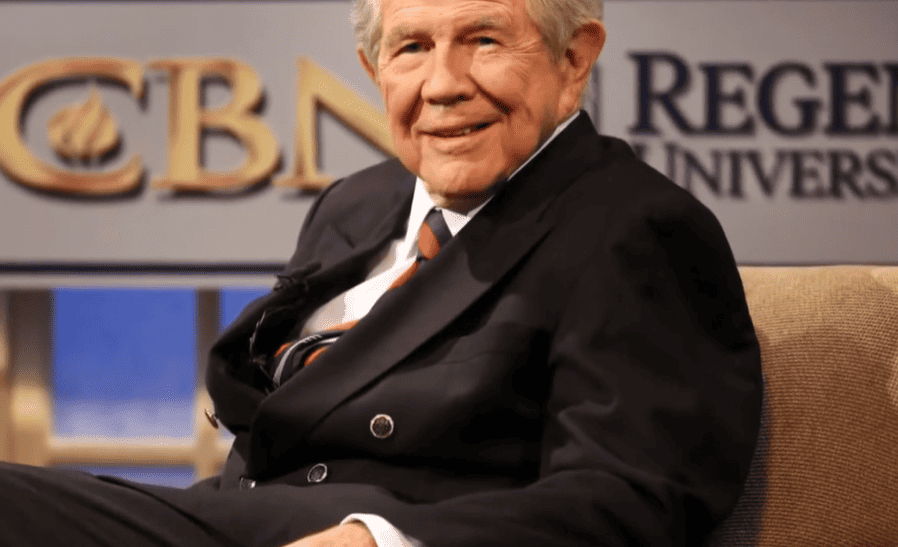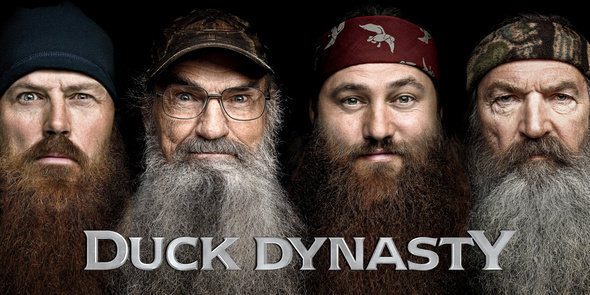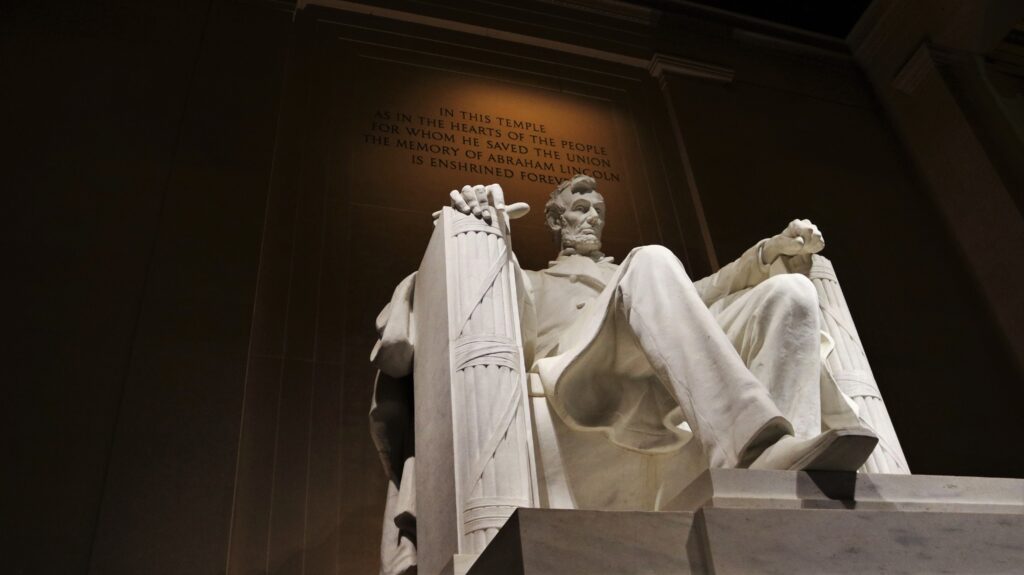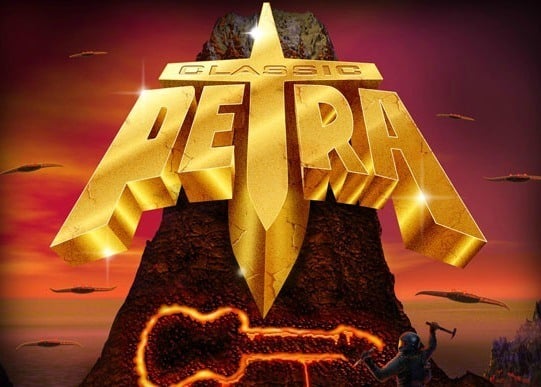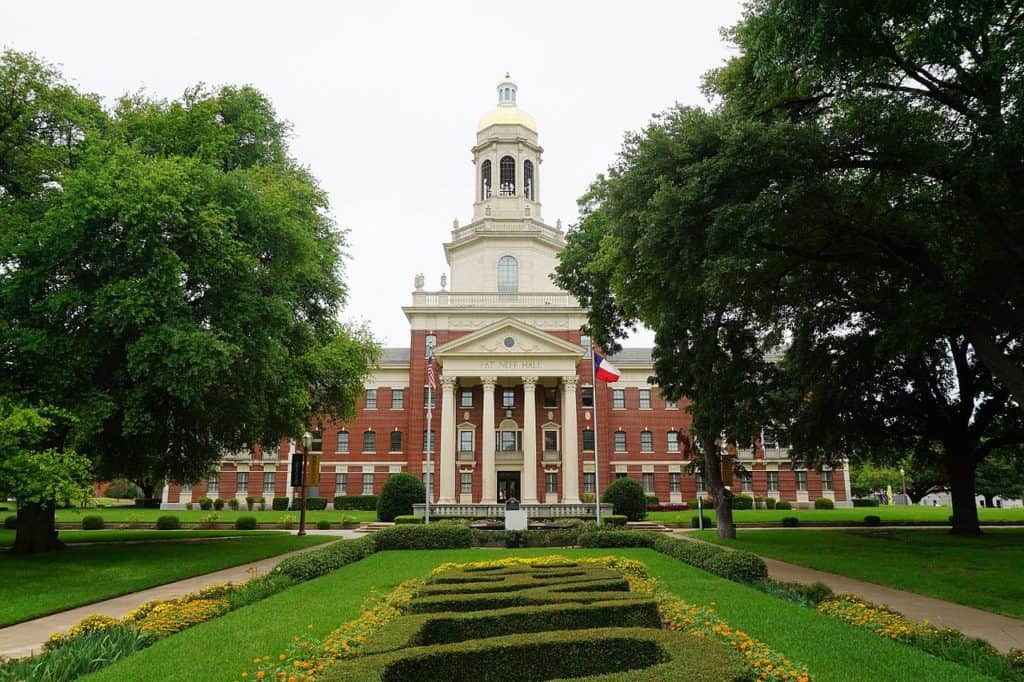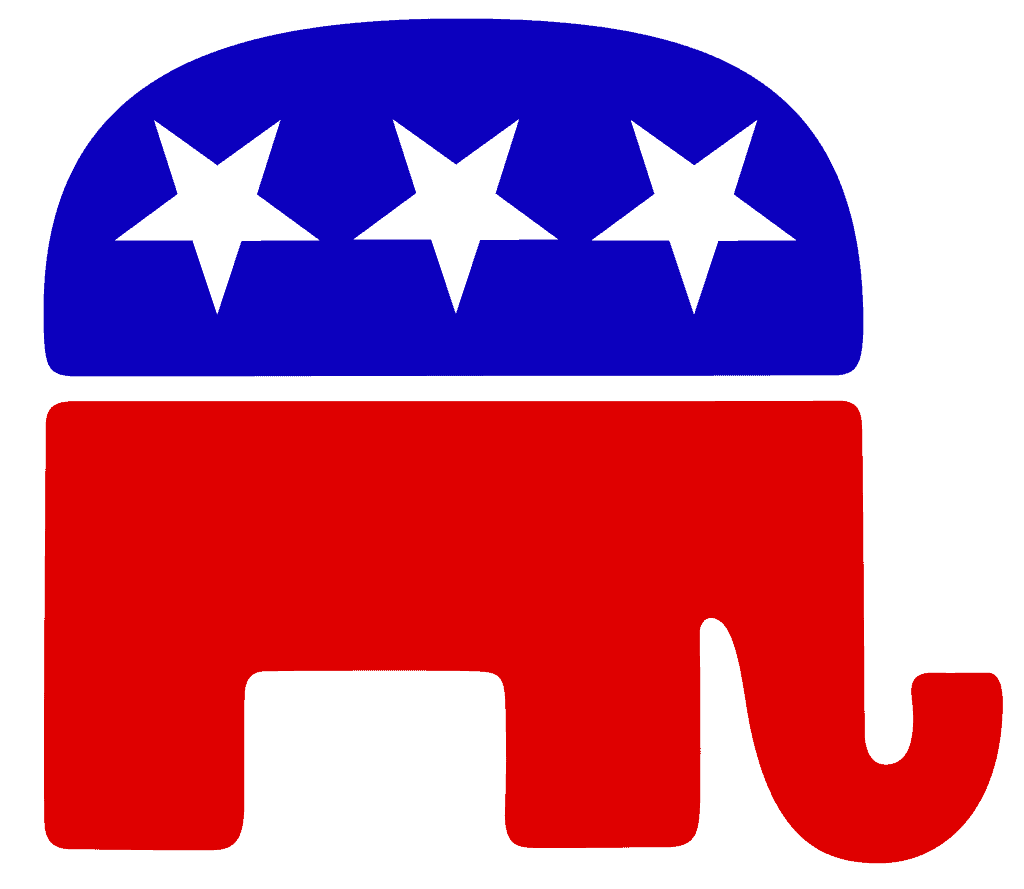“Ladies and Gentlemen,” declared former Los Angeles Rams defensive tackle Rosey Grier, “Pat and Dede Robinson!” Immediately realizing his gaffe, Grier added, “Robertson! Pat and Dede Robertson!” The couple emerged from a townhouse behind the stage that Robertson’s campaign had erected in the Bedford-Stuyvesant neighborhood of Brooklyn, New York. A brass band played the instrumental anthem “Gonna Fly Now!” from Sylvester Stallone’s Rocky films. Instead of a perspiring Italian boxer, a quintessentially Waspy elderly couple took the stage to wave at their supporters as well as a group of protestors who carried signs with slogans like “Robertson and Khomeini in ’88.” After some assistance from Grier, Dede found her spot on the platform, and the perpetually grinning Robertson turned to address his audience.[i]
Evangelicals and the Republican party become allies
Marion G. “Pat” Robertson’s announcement on October 2, 1987, heralded the start of a campaign that both demonstrated the continuing political clout of conservative American evangelicals and shaped the future course of conservative evangelical political activism. Lessons learned from the Robertson campaign, possibly from its failures as much or more than its successes, enabled conservative evangelicals to determine critical changes they would need to make if their effective political influence was to continue. Most importantly, Robertson’s campaign cemented the alliance between conservative evangelical activists and the Republican Party that had been evolving for decades. Political commentator, John McLaughlin wrote in a 1986 editorial piece for National Review that despite the impossibility of Robertson winning the presidential nomination, “Robertson’s impact will be felt nevertheless. His most enduring legacy could be the deghettoizing of the Religious Right.”[1]
Pat Robertson had founded the Christian Broadcasting Network in the early sixties after serving in the Marine Corps as well as earning degrees in law and theology. He was unable to pass the bar exam and pursued ordination as a Southern Baptist minister after his graduation from New York Theological Seminary. From the start of his campaign, Robertson wrestled with the question of how tightly he should hold on to his ministerial persona if he wanted to break into the political mainstream. The struggle was not unique to Robertson. Several evangelicals in a variety of fields from Christian music to popular publishing, whose rise to prominence had been due to the agency of the evangelical subculture, were now being confronted with the option to play to a bigger audience but at the risk of being rejected by evangelicals who viewed these leaders and artists as “theirs.” Jerry Falwell, pastor of Thomas Road Baptist Church in Lynchburg Virginia, and founder of the Moral Majority, tended to operate explicitly as a pastoral political activist and spiritual counselor for political leaders. Robertson rejected this paradigm in favor of emphasizing his legal, business, and media credentials rather than his roles as an ordained minister and televangelist. He even went so far as to divest himself of his Southern Baptist ministerial ordination.[2] His attempts to leave his televangelist persona behind led to interesting and often comical results on the campaign trail.
From ministry to political activism
NBC News anchor Tom Brokaw attracted Robertson’s ire when his evening news program began to run segments on Robertson’s televangelist past and charismatic proclivities. A segment aired on December 21, 1987, included references to Robertson’s claims to have diverted the path of Hurricane Gloria in 1985 through the combined prayers of his staff, an event which he credited with affirming that it was God’s will that he run for president.[3] Robertson’s triumphant proclamation of God’s deliverance overlooked the fact that Gloria slammed into the Mid-Atlantic and New England states with devastating injuries, the loss of fourteen lives, and damage to property after it bypassed Virginia. When asked by a reporter if the event affected his decision to run for president, Robertson replied, “It was extremely important because I felt, interestingly enough, that if I couldn’t move a hurricane, I could hardly move a nation.”[4] The same news segment included a clip from Robertson’s show The 700 Club in which Robertson announced to his astonished co-anchors that only Christians and Jews were qualified to be political leaders. When co-anchor Ben Kinchlow tried to reframe and clarify Robertson’s remarks, Robertson responded, “Yes, I said that. I believe it.”[5] Robertson became increasingly testy in his interactions with Brokaw and NBC. Tensions culminated after Robertson’s second-place finish in the Iowa Caucuses when Brokaw referred to him as a “television evangelist” in an interview. Brokaw asked if Robertson consulted God on all his political decisions as he had claimed to do on all his decisions while he was a televangelist. Robertson responded, smiling through clenched teeth, that this was the last time he wanted to be categorized as a “televangelist.” He insisted, “I run the fifth largest cable network in America. I’m in 37 million households with cable which is enough to rival some of the so-called big boys.” He went on to characterize Brokaw’s question as “religious bigotry” and asserted, “I really believe that henceforth the religious bigotry that your question implies is going to be a dead issue.”[6]
While Robertson did indeed have an incredibly diverse range of professional roles on his resume, his continued insistence that he was not a television evangelist made him a subject of ridicule in the national media. It was simply too easy to prove that he, in fact, was. Saturday Night Live had fun with Robertson’s reticence to be characterized as a “television evangelist” when the comedy sketch program ran a mock Republican presidential debate on its February broadcast. Comedian Al Franken played Robertson to grinning perfection and delighted the audience with his recitation of all the other things he had done besides televangelism including mowing lawns, watching people’s homes while they were on vacation, and being a caddy at one of the biggest country clubs in Virginia.[7]
It was not a great time to be a television evangelist in American popular culture. Televangelists enjoyed great success throughout the eighties, but the end of the decade brought the collapse of several high-profile ministries that blackened the reputation of televangelism. Jim and Tammy Bakker’s multiple PTL (Praise the Lord) ministry scandals erupted in the spring of 1987 and continued throughout 1988 as further revelations came to light. Jerry Falwell, the most visible leader of the Religious Right at the time, was tapped to help right the ship at PTL. He ultimately became associated with the scandal as accusations flew between him and the Bakkers over his management of PTL. Another scandal was brewing in Louisiana. Baton Rouge televangelist Jimmy Swaggart was accused of soliciting a prostitute to perform “pornographic acts” for him in a New Orleans hotel room. Swaggart’s infamous televised confession occurred on February 21, 1988, just a few weeks before the pivotal “Super Tuesday” primaries on March 8. Robertson implied to reporters on February 23 that the timing of Swaggart’s confession was no accident. When asked if he was accusing the George H. W. Bush campaign, Robertson said, “Knowing the quality of people surrounding George Bush, there is nothing that I would not believe they wouldn’t do sleazy.”[8] Bush denied Robertson’s allegations.
Robertson had good reason to be concerned about the damage Swaggart’s fall might inflict on his presidential prospects at that critical point in the campaign season. He had surprised many pundits with his second-place finish in the Iowa caucuses, finishing behind Kansas Senator Robert Dole and ahead of incumbent Vice President George H. W. Bush. Robertson won 25 percent of the vote in contrast to Bush’s disappointing 19 percent showing. His win in Iowa followed a strong second-place finish in Michigan on January 19 and a win in Hawaii on February 4. Pundits who had dismissed Robertson’s candidacy discussed the possibility that he might pose a more serious challenge to Bush in the wake of the Iowa Caucuses.[9] Unfortunately for Robertson, his momentum took a devastating hit in the New Hampshire primary on February 16. Robertson placed fifth in New Hampshire with only nine percent of the vote. Bush’s campaign was reinvigorated with his win in New Hampshire. It was essential for Robertson to do well in the Super Tuesday primaries to keep his candidacy alive.
Falwell’s Moral Majority holds sway
Another formidable difficulty for Robertson going into the Super Tuesday contests was the lack of united support he could claim from other conservative evangelicals. Vice President George H. W. Bush cultivated his relationship with Jerry Falwell and the Moral Majority as early as January 1986 with public remarks praising the “moral vision” that Falwell’s followers had brought to the American political process.[10] Falwell endorsed the vice president as early as 1986 for the 1988 election. Robertson’s candidacy posed a difficult question for Falwell and conservative evangelicals across the country. Would they transfer their support for Ronald Reagan to Reagan’s vice president or to the more overtly Christian Robertson? Bush’s mainline Episcopalian affiliation and his lack of demonstrative religious expression concerned some potential evangelical supporters. But a fundamentalist Baptist like Jerry Falwell was no more enamored with Robertson’s charismatic tendencies. Falwell continued to support Bush as the primary season began, leaving evangelicals who had looked to his Moral Majority for political leadership to decide if they would follow his lead or take a chance on Robertson. There was real potential for conservative evangelical political activists to be significantly and, perhaps permanently, divided going forward.
Super Tuesday proved to be the beginning of the end for most of Bush’s challengers. The vice president swept most of the fourteen states in play. Robertson won only Washington. Both Robert Dole and Representative Richard Gephardt of Missouri left the race by the end of March with Robertson vowing to fight on despite the impossibility of actually winning the nomination after Super Tuesday.[11] Robertson held on for another month before deciding to drop out of the race with a formal announcement on April 6. He emphasized the importance of his support for Bush by stating, “If George Bush moves toward the center, then perhaps these people (social conservatives) will be left out unless somebody like me enunciates the issues and in turn says George Bush is our man.”[12] The question of whether Robertson would choose to be that someone remained on the table as Republicans looked to their national convention set for August in New Orleans, Louisiana.
“Our” party
Robertson was slated to speak at the Republican National Convention on August 16. With the majority of his fellow evangelicals already falling in line to support the Republican nominee, it only remained for Robertson to throw his own endorsement to the vice president. Using imagery from Charles Dicken’s Tale of Two Cities, Robertson engaged in a bit of hyperbole by comparing a world under Democrat rule to the anarchic chaos of the French Revolution. He closed with the proclamation, “Tonight I release my delegates and alternates who have come to this convention and urge you and all of my friends across America to give your enthusiastic support to our party, our candidates, and our presidential nominee, George Bush.”[13] The alliance between conservative evangelicals and the Republican Party had survived its first post-Reagan test without a major splinter in the evangelical ranks. Evangelicals chose to support Bush despite their misgivings that he would not address the social issues that formed the core of their political platform. For better or for worse, evangelicals joined Robertson in recognizing the Republican Party as “our” party and would continue to do so for the next thirty years.
The postmortem that followed Robertson’s campaign resulted in a significant reshaping of conservative evangelical political activism in American public life. Robertson expressed his conviction that God’s purposes for his presidential run transcended personal victory. He wrote in his 2008 book The Plan:
Could it be that the reason for my candidacy has been fulfilled in the activation of tens of thousands of evangelical Christians into government? This campaign taught them that they were citizens with as much right to express their beliefs as any of the strident activists who have been so vocal in support of their own radical agenda at every level of our government. For the first time in recent history, patriotic, pro-family Christians learned the simple techniques of effective party-organizing and successful campaigning.[14]
Robertson took a leading role in harnessing this growing evangelical political savvy and funneling it into more effective political organizations. Jerry Falwell’s decision to dissolve the Moral Majority in 1989 opened the door for Robertson and his allies to guide formal political activism among evangelicals for the next decade.[15]
Robertson’s acute sensitivity to the label “televangelist” grew from his conviction that people would not take him seriously as a presidential contender if they viewed him primarily as a minister. That problem became even more acute as the televangelist scandals provoked public disgust with Christian media ministries. The organizations that formed in the wake of Robertson’s presidential bid were led by individuals who shared Robertson’s values, but had received their education and built their reputations in areas outside of formal ministry. Robertson founded the Christian Coalition in 1989 and tapped Ralph Reed, a Ph.D. candidate in history at Emory University, to serve as the organization’s executive director. Robertson renamed his Christian Broadcasting Network University, founded in 1977, and Regent University in 1990.[16] The American Center for Law and Justice (ACLJ) was founded in connection with Regent’s School of Law as a legislative arm with the stated mission to protect constitutional and human rights around the world. This mission usually translated into legal protection for Christians in disputes over church/state issues. Jay Sekulow, an attorney with a background in tax law, became the Chief Counsel for ACLJ in 1992. Like Reed, Sekulow brought the legitimacy of professional training and no ministerial past while also holding to Robertson’s conservative values.[17] With rare exceptions, such as ordained minister former Governor Mike Huckabee, conservative evangelicals after the Robertson campaign invested their support in political operatives without formal ministerial credentials while the ministers carried the torch by mobilizing that support.
Seeking theological respectability
Evangelical political activists in the wake of Robertson’s presidential run had also tended to avoid the sort of providential language and association with charismatic spirituality that Robertson demonstrated in the years leading up to his campaign. Robertson’s insistence on being identified as an evangelical rather than a charismatic or Pentecostal Christian was constantly challenged by the body of material he had produced over the course of his ministry. Examples of Robertson’s claims to faith healing through a “word of knowledge” and charismatic/dispensational interpretations of key passages of scripture abounded. Just as charismatic spirituality was an unseen engine driving the popular evangelical subculture, an engine that was pivotal yet submerged for the sake of broad unity, charismatic commitments also became a more muted sub-current in evangelical political activism. Following Robertson’s lead, charismatic evangelicals aspiring to public office endeavored to keep their participation in esoteric practices more specific to their particular sub-tradition of Christianity such as faith healing, speaking in tongues, and being “slain in the Spirit” within the walls of their congregations and out of the public eye. They have been largely successful in fostering a broad lowest common denominator theological inclusivity within the Republican Party. Their strategy of subordinating theological distinctions to political pragmatism has allowed conservative charismatics like Sarah Palin and Michelle Bachman to run for office with few alarms being raised about the nature of their personal theology. Like so many things that defied convention in the Trump era, this veneer of theological respectability began to slip with the theatrical proclamations of charismatic and Neo-Pentecostal Trump supporters such as Florida pastor Paula White. Her open use of spiritual warfare imagery to condemn Trump’s critics indicated an emboldened conservative evangelicalism unconcerned with letting more radical tendencies show that would have been deemed beyond the pale in 1988.
The Pat Robertson presidential campaign raised provocative questions regarding how the religious conservatives who supported Ronald Reagan would continue their pursuit of political influence. While Robertson himself failed to capture sufficient support for his presidential bid, the lessons evangelicals and other religious conservatives learned from the experience prompted critical developments that propelled them to new heights of influence within the Republican Party over the next two decades. Their quest for respect and respectability within the Republican Party has transformed the party and the ways Republicans approach the public square with results that either excite or terrify depending on the perspective of the beholder while posing important questions about the long-term viability of the party.
Footnotes:
[1] John McLoughlin, “Preacher Pat,” National Review, May 23, 1986.
[2] Steven P. Miller, The Age of Evangelicalism: America’s Born Again Years, Oxford, UK: Oxford University Press, 2014, 81-86.
[3] Lisa Meyers, “NBC News Report: Pat Robertson’s 1988 Presidential Bid,” December 21, 1987, https://search.yahoo.com/search;_ylt=A0LEV02xRilWICQAIFZXNyoA;_ylc=X1MDMjc2NjY3OQRfcgMyBGZyA3lmcC10LTkwMS1zBGdwcmlkA08ySnE2ZUhsUWJtZk90Q1o5MllidkEEbl9yc2x0AzAEbl9zdWdnAzAEb3JpZ2luA3NlYXJjaC55YWhvby5jb20EcG9zAzAEcHFzdHIDBHBxc3RybAMEcXN0cmwDMjQEcXVlcnkDUGF0IFJvYmVydHNvbiBUb20gQnJva2F3BHRfc3RtcAMxNDQ1NTQ1Njky?p=Pat+Robertson+Tom+Brokaw&fr2=sb-top-search&fr=yfp-t-901-s&fp=1 , Accessed October 22. 2015.
[4] Associated Press, “Pat Robertson Says Storm Put Him on Path to ’88 Bid : Prayer Diverted Hurricane, Robertson Asserted on TV,” Los Angeles Times, September 17, 1986, http://articles.latimes.com/1986-09-17/news/mn-10637_1_pat-robertson , accessed October 22, 2015.
[5] Lisa Meyers, “NBC News Report: Robertson Presidential Bid.”
[6] Tom Wicker, “Tea-leaf Readers May Do Better At Assessing Iowa Caucuses Than Other Pundits,” The New York Times, February 12, 1988, http://articles.sun-sentinel.com/1988-02-12/news/8801090781_1_caucuses-iowa-democrats-nostradamus-university , Accessed October 22, 2015. Jim Heath, 1988 Presidential Campaign Recap, https://search.yahoo.com/search;_ylt=A0LEV0NRyitW4gkATE5XNyoA;_ylc=X1MDMjc2NjY3OQRfcgMyBGZyA3lmcC10LTkwMQRncHJpZAM0Z2ZQaDFUTFRhQzN3aDg0eHNHbGRBBG5fcnNsdAMwBG5fc3VnZwM0BG9yaWdpbgNzZWFyY2gueWFob28uY29tBHBvcwMwBHBxc3RyAwRwcXN0cmwDBHFzdHJsAzQwBHF1ZXJ5A1BhdCByb2JlcnRzb24gMTk4OCBkcm9wcyBvdXQgb2YgdGhlIHJhY2UEdF9zdG1wAzE0NDU3MTA0NjI-?p=Pat+robertson+1988+drops+out+of+the+race&fr2=sb-top-search&fr=yfp-t-901&fp=1, 42:00-45:00, Accessed October 24, 2005.
[7] Saturday Night Live, “Republican Presidential Debate Sketch,” https://search.yahoo.com/search;_ylt=AwrBT.Tp1itWjngALLtXNyoA;_ylc=X1MDMjc2NjY3OQRfcgMyBGZyA3lmcC10LTkwMQRncHJpZANtckFqUU01Z1MxR1F1dk5BdDVlNnhBBG5fcnNsdAMwBG5fc3VnZwMxMARvcmlnaW4Dc2VhcmNoLnlhaG9vLmNvbQRwb3MDMQRwcXN0cgMEcHFzdHJsAzAEcXN0cmwDMjcEcXVlcnkDYWwgZnJhbmtlbiBhcyBwYXQgcm9iZXJ0c29uBHRfc3RtcAMxNDQ1NzE0MzE3?p=al+franken+as+pat+robertson&fr2=sa-gp-search&fr=yfp-t-901&fp=1, Accessed October 24, 2015. SNL Transcripts, “Republican Debate, Season 13, Episode 11,” http://snltranscripts.jt.org/87/87kdebate.phtml , Accessed October 24, 2015.
[8] Robin Toner, “Robertson Hints a Bush Link to Disclosures on Swaggart,” The New York Times, February 23, 1988, http://www.nytimes.com/1988/02/24/us/robertson-hints-a-bush-link-to-disclosures-on-swaggart.html , Accessed October 22, 2015.
[9] Craig Johnson and James E. Wilkerson, “History of the Iowa Caucuses, 1988,” Des Moines Register, http://caucuses.desmoinesregister.com/data/iowa-caucus/caucus-history-gop/index.php , Accessed October 24, 2015.
[10] Phil Gailey, “Bush Salutes Falwell Conservatism,” The New York Times, January 25, 1986.
[11] James O’Toole, “Dole leaves race, urges keeping GOP in the White House,” The Pittsburgh Post- Gazette, March 30, 1988.
[12] “Robertson Drops ‘Quixotic’ Campaign,” The New York Times, April 7, 1988.
[13] Pat Robertson, “A Presidential Bid Ended,” August 16, 1988, http://www.patrobertson.com/Speeches/PresidentialBidEnded.asp, October 24, 1988.
[14] Pat Robertson, The Plan: A Candid Look at Pursuing God’s Plan for Our Lives, Nashville, TN: Thomas Nelson Publishers, 1989, 70. .
[15] Miller, 80-100.
[16] Ibid.
[17] Regent University, “History,” Regent University Official Site, http://www.regent.edu/about_us/overview/history.cfm , Accessed October 24, 2015. American Center for Law and Justice, “About ACLJ,” ACLJ Official Site, http://aclj.org/our-mission/about-aclj, Accessed October 24, 2015.
[i] Robertson Presidential Campaign Announcement, C-Span, October 2, 1987, http://www.c-span.org/video/?3191-1/robertson-announcement, accessed October 22, 2015.

